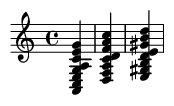Summary:
The minor blues progression transforms the familiar 12-bar blues by using minor chords, creating a darker, more sophisticated, and introspective emotional landscape. While preserving the core structure of traditional blues, this progression introduces richer harmonic possibilities that have become foundational in jazz, soul, rock, and modern music, offering a powerful vehicle for profound emotional expression.
Keywords:
minor blues progression, 12-bar minor blues, jazz blues, minor chord progressions, blues harmony, music theory, improvisation scales, emotional expression
Introduction: What is the Minor Blues?
While most people associate the blues with a raw, gritty sound built on dominant seventh chords, a parallel tradition offers a deeper, more melancholic form of expression: the minor blues. By shifting the harmonic foundation from major to minor, musicians unlock a world of emotional nuance. This progression is more than just "sad blues"; it's a sophisticated canvas for introspection, tension, and soulful storytelling. It has been a cornerstone for genres that demand harmonic depth, from the smoky clubs of jazz to the passionate anthems of rock and soul.
The Basic 12-Bar Minor Blues Structure
The most common minor blues form follows the classic 12-bar structure. In the key of A minor, it uses the tonic (i), subdominant (iv), and dominant (V) chords. Notice how the first and fourth chords are minor, immediately setting a different mood from the major/dominant chords of a standard blues. The V chord is typically a dominant 7th to create a strong pull back to the tonic.
Standard Minor Blues in A Minor:
This is the fundamental i-iv-V chord sequence. The Roman numerals are: i - i - i - i - iv - iv - i - i - V - iv - i - V.
Chord Functions and Emotional Impact
Each part of the 12-bar form serves a distinct function that contributes to the progression's narrative arc.
- Bars 1-4 (i chord - Am) : Establishes the introspective "home" base or tonic. This section sets a contemplative mood.
- Bars 5-6 (iv chord - Dm): Moves to the subdominant, creating a feeling of gentle lift or departure. In a minor key, this change often feels like a deep sigh or a reflective question.
- Bars 7-8 (i chord - Am): Returns to the tonic, reinforcing the home key before the final section builds tension.
- Bars 9-10 (V chord to iv chord - E7 to Dm): This is a key moment. The powerful V chord (E7) creates strong tension, but instead of resolving immediately home, it moves to the iv chord (Dm). This "deceptive" movement is harmonically sophisticated and emotionally poignant, delaying resolution.
- Bars 11-12 (i chord and V chord - Am and E7): Known as the turnaround, this section brings us back to the beginning. The final V chord leaves the listener hanging, ready for the cycle to repeat.
Adding Color with Seventh Chords
To add harmonic richness, musicians almost always use seventh chords. This adds a layer of complexity and creates smoother connections between chords. The standard progression becomes i m7 - iv m7 - V 7.
Minor Blues with Seventh Chords in A Minor
Here are common four-note voicings for each chord, demonstrating smooth voice leading.

Scale Choices for Improvisation
Improvising over a minor blues is a chance to tell a story. Different scales can act as your vocabulary, each with its own flavor. Here are the essential choices for an A minor blues:
1. A Minor Pentatonic Scale
The safest and most fundamental choice. It works over the entire progression and provides that classic, soulful blues sound. Notes: A, C, D, E, G.
2. A Blues Scale
This is the minor pentatonic with an added "blue note" (the b5) . This note adds a gritty, dissonant flavor perfect for blues. Notes: A, C, D, Eb, E, G.
3. Using Modes for More Color
For a more sophisticated sound, especially in jazz, you can match different minor scales to the chords:
- Over Am7 and Dm7 (i and iv chords) : Use A Dorian (A-B-C-D-E-F#-G). The F# (the major 6th) adds a touch of brightness and sophistication compared to the natural minor scale.
- Over the E7 (V chord): Use A Harmonic Minor (A-B-C-D-E-F-G#). The G# is the crucial note here. It's the major third of the E7 chord and acts as a powerful leading tone, pulling your melody strongly back to the root note, A.
Famous Examples of Minor Blues
The minor blues progression is the backbone of many iconic songs across different genres. Listening to these will give you a feel for its emotional power and versatility.
- "The Thrill Is Gone" by B.B. King: The quintessential slow minor blues. Its mournful yet dignified feel is a masterclass in emotional expression.
- "Black Magic Woman" by Santana: A classic rock staple built on a simple minor blues form, showcasing its potential for a driving, hypnotic groove. - "Equinox" by John Coltrane: A classic jazz take on the minor blues, demonstrating its use as a vehicle for advanced modal improvisation. - "St. James Infirmary Blues" (Traditional): While an 8-bar form, this classic song embodies the deep, melancholic spirit of minor blues and has been arranged in a 12-bar format by countless artists.
Advanced Concepts: The Jazz Minor Blues Turnaround
In jazz, musicians often substitute chords to add harmonic interest. A very common variation occurs in bars 9-10. Instead of the V-iv (E7-Dm) movement, they use a ii-V progression.
- Bars 9-10: Bm7b5 → E7
This `ii-V-i` cadence (Bm7b5 - E7 - Am7) is a fundamental building block of jazz harmony. It creates a stronger, more satisfying sense of resolution when it finally lands on the Am7 chord in bar 11. This small change elevates the progression and opens up new melodic possibilities for improvisation.
Instrumental & Rhythmic Considerations
The way the progression is played is as important as the notes themselves.
- Rhythm: Minor blues works beautifully as a slow, 12/8 ballad (like "The Thrill Is Gone"), a medium shuffle, a Latin groove, or with a straight-eighth rock feel. The rhythm dictates the energy.
- Guitar: Techniques like slow string bends, expressive vibrato, and fingerpicking arpeggios are perfect for conveying emotion.
- Piano: Comping with rich 7th, 9th, and 13th chords adds sophisticated color, while melodic lines can weave through the changes using the scales mentioned above.
- Bass: A solid bassline outlining the root, fifth, and seventh of each chord is crucial. A great bassist will create a melodic counterpoint that complements the soloists.
Practice Strategies for Mastery
Mastering the minor blues is a journey. Here’s a roadmap:
- Internalize the Form: Play just the basic chords on a piano or guitar until the 12-bar structure is second nature. Use a metronome.
- Learn the Melodies: Learn the vocal melodies or main instrumental themes from classic minor blues songs. This teaches you how great musicians phrase over these changes.
- Practice Scales Over a Backing Track: Record yourself playing the chords or find a minor blues backing track online. Practice improvising using one scale at a time (e.g., just minor pentatonic) before mixing them.
- Target the Changes: Consciously try to use the A Harmonic Minor scale over the E7 chord to highlight that G# leading tone. You will hear your solos immediately sound more professional.
- Transcribe Solos: Learn a few licks or a full solo from a master like B.B. King or John Coltrane. This is one of the fastest ways to build your vocabulary.
Conclusion: A Gateway to Deeper Expression
The minor blues progression is far more than a set of chords; it's an emotional and harmonic landscape. It retains the heart and soul of the blues while adding a layer of sophistication that has allowed it to flourish in jazz, rock, and beyond. By understanding its structure, exploring its melodic possibilities, and absorbing the feel of its classic examples, you gain access to one of the most powerful tools for musical storytelling. It's a progression that challenges the mind, speaks to the heart, and will endlessly reward your musical exploration.
References:
King, B.B. (1969). The Thrill Is Gone. BluesWay Records.
Coltrane, John. (1960). Equinox. From the album "Coltrane's Sound". Atlantic Records.
Levine, Mark. (1995). The Jazz Theory Book. Sher Music Co.
Baker, David. (1986). How to Play Bebop, Vol. 3: The II/V7/I Progression. Alfred Music.
